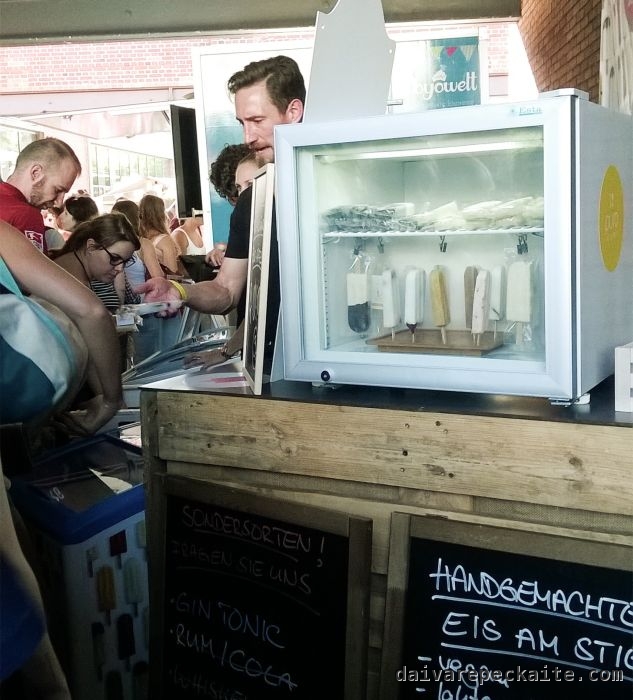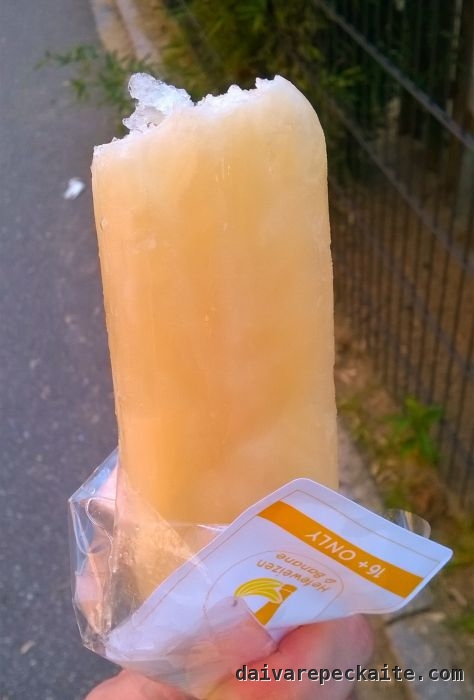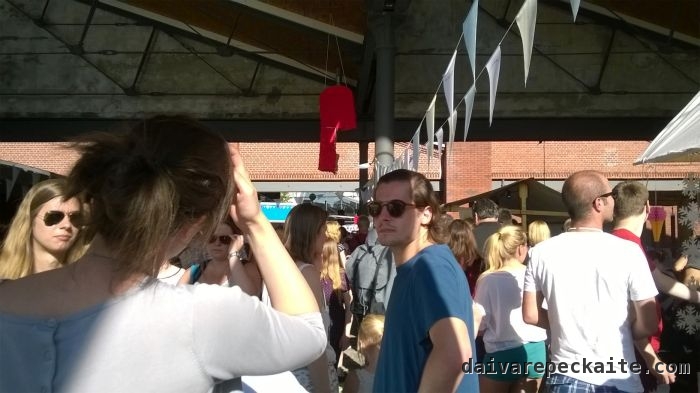Like many people I know in Hamburg, I join all remotely interesting Facebook events if they pop up somewhere. Aside from being an idea for what to do with my free time, an ice cream market in Hamburg sounded like a great new experience, particularly because Germany is a great place to enjoy vegan and lactose-free versions of popular ice cream sorts. To the joy of organizers and visitors, the weather was perfect for an event like this. The event itself was… less than perfect.
The event took place close to Hamburg′s exhibition center, near the bustling neighborhood of Sternschanzen, where the main bars and clubs are located. With a little bit of time on their hands, parents, students, pupils, creatives and all kinds of other residents in Hamburg were destined to flock to such a summery event. Co-sponsored by mint&berry, a fashion brand, the event played heavily on instagram and sounded very promising in posters.
When I got there, I saw a huge line at the entrance. Security guards were letting people in in groups, not too many at a time. Although there was plenty of space in the closed area, people were very unevenly distributed. Huge areas in the sun were only to be crossed, and dense crowds sweated around six stands of ‘ice cream artists’, most of them from Berlin. There was also a little stage where mint&berry clothes were hanging – people could check them out, and a stylist was waiting to offer a summery make-up for those who wanted.
The crowd at the entrance was not the only issue. There were huge lines at each ice cream stool, some of them in scorching sun. Even people with babies and toddlers patiently waited for their turn. I think the event had an “if we have already come here, we can wait a little longer” effect. People waited patiently, without complaining much. What a subtle form of masochism – all for the sake of gastronomic pleasure.
Was the pleasure worth it? Having surveyed all the stools, I decided to first try only the things I cannot find at home. Someone had an awesome idea – if the popular dessert is so strongly associated with ice, why not exploit another attribute of winter – snow?
This is a vegan version, but there are also snow ice creams with milk. The ‘ice cream artist’ (apparently it′s a term) takes a large cylinder of ice-cream concentrate and places it into a machine, which produces this airy, fragile-looking texture. With a little bit of effort it could become a really artistic dessert and a big hit in Lithuania, too. Its taste is not special in any way, and when it melts its texture also becomes like a regular sorbet.
The organizers did not care at all where people would sit. There were three cafes around, but to sit there one would have to buy something in addition to the ice cream. Many were sitting on the ground, competing for the limited shaded space. I found a something between a palette and a bench to sit on. But soon enough a young mother next to me decided to change her baby′s diaper without thinking that people who are eating might be disgusted by it. Having tried sitting on the ground next to a group of young smokers, I decided that the most enjoyable way to eat ice cream would be while standing.
Or perhaps standing in the next line? Puro, another company from Berlin, seemed to be very popular, and the offer of espresso and coconut ice cream got me dreaming.
Unfortunately, before my turn came, they ran out of the most interesting sorts: espresso-coconut and avocado-lime. But they still had several sorts with alcohol. Mojito and gin tonic were more expensive, and I settled for banana and wheat beer.
This sorbet was pure perfection and the only thing that made it worth coming here. Transparent, but rich in texture, tasteful and not sugary, with a unique combination of flavors, the sorbet earned its creators the title of ice cream artists.
I could have tried something else, but the lines were just impossible. mint&berry, which presented a retro-style fashion collection, also offered an opportunity to win vouchers for those who took photos of themselves in a photo booth and tagged them on instagram. People patiently lined up for this.
My trip to the US already made me think about the patience people have for lining up. I am a child of the Perestroika, and some of my first childhood memories have to do with standing in impossibly long lines to buy products. Relatives and family friends who had already had a chance to travel abroad would then tell stories about Western shops, where everything was readily available. For me and many people of my generation the idea of free market meant, above all, that people with money can get what they want when they want it. Of course, people may have to endure inconveniences related to their purchases, but this happens when they want to save. Want to visit MoMA for free or enjoy BBC Proms for 5 pounds? Fair enough, for every cent you save, you pay with your time. Want to reach point B in another country with little money? Fly Ryanair, but good luck waiting for boarding in crammed claustrophobic spaces at cheap airports, or enduring inconvenient transfers.
Time is the currency that poor people must use to get things they need or want. Waiting for buses or delayed trains, killing time at airports just because transportation is scarce and it is better to arrive well in advance, lining up for goods on special offer and at sales – all of this comes with the hope to save, or out of pure necessity. In Hamburg, I am a poor Eastern European expat, who can′t enjoy such a variety of vegan options in her milk-loving country. But why are all these people doing it to themselves?
(I had more photos of crowds, but it wasn’t possible to prevent close-ups and allow ice-cream-lovers some privacy, so in this one at least all visible faces are with sunglasses – street photography is severely restricted in Germany!)
The price was clearly not a factor. While entry to the ice cream fair was free, the ice cream cost 2.5-4 eur (vs 1 eur a scoop in the city). The fact that the ‘artists’ came all the way from Berlin should not be a big deal in Germany′s second-largest city.
The answer is clear, and those of us who grew up saying “never again” to Soviet lines had to eventually learn that in fact, the main difference between planned economies and advanced capitalist economies is all about who does the planning. Businesses know that demand emerges when people think they need something, and that this thing is in short supply. If potential customers are not quite sure they need it, businesses will tempt, cajole, threaten, play up people’s fears. and ostracize to convince them otherwise. Because businesses have planned to sell a certain number of products and will do everything to sell them.
There were several factors, it seems, that contributed to the patience of the customers. Firstly, the event was marketed well on social networks as the summer festival of this weekend. Festivals are all about crowds anyway. People in Hamburg seem to love being in a crowd, even without any particular purpose. Yesterday I went to a Beckstrasse fest, where people were sitting around on the street, drinking and listening to music. Since drinking outside is legal in Germany, young people often buy beer from kiosks and crowd in the Schanzen quarter. Even more interestingly, they often gather around popular bars, thus adding to their popularity (it looks like the bar is so popular that large crowds are standing outside).
Secondly, the organizers creatively played with the idea that you are winning something. Wait at the entrance, then wait for an ice cream, then line up for the photo booth to post a photo of yourself with ice cream on instagram and maybe, just maybe, win a voucher to buy some, honestly, very average retro clothing! The cross-shaped space did not allow visitors to see that there are actually very few ice cream stools, and the event looked big only form the outside. Most of the area was unused space, where it was too hot to stand.
Thirdly, the whole aura of short supply also did the trick, with sellers crossing out menu items in chalk. The event was marketed as unique and immensely popular in Berlin, perhaps playing up the inferiority, typical for second cities in almost every country. Had they invited local ice cream ‘masters’, at least some of the visitors would have picked up a flyer and come to try out the ice cream at some other time.





